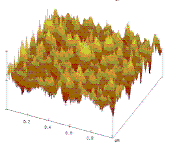Chemical and Biomolecular Research Papers -- Faculty Authors Series

Anuradha Subramanian Publications
Document Type
Article
Date of this Version
2011
Abstract
Zirconia particles were prepared from a 20% colloidal sol (ZrO2) by the polymer-induced colloid aggregation (PICA) process, both in the presence and absence of porogens. Specifically, porous zirconia particles having varying porosity were prepared by a two-step protocol wherein a porogen was first embedded during the particle synthesis, followed by its removal in a subsequent step. In this research study, the ability of four different types of porogens, viz. fumed silica, micronized high molecular weight polyethylene emulsion ME09730, and microcrystalline waxes ME48040M2 and ME98040M1, to impact the pore size, porosity, and pore area were investigated. Particle morphology and porosity of the resultant particles were characterized by scanning electron microscopy, mercury intrusion–extrusion porosimetry, and the nitrogen adsorption–desorption sorptometry. Optimal ratios of zirconia sol and porogen to yield the largest unimodal distribution of pores were determined. Porous zirconia particles were obtained after the removal of porogen, followed by a calcination and sintering protocol. Particle aggregates were typically 7–45 μm in diameter, with BET surface areas between 21 and 54 m2/g and pores ranging from 18 to 120 nm in diameter. The nitrogen sorptometry and mercury porosimetry data of these support particles were modeled to calculate surface fractal dimension, pore accessibility parameters, pore network, and pore geometry.


Comments
Published in International Journal of Applied Ceramic Technology 8:1 (January/February 2011), pp. 94–111; doi: 10.1111/j.1744-7402.2009.02410.x Copyright © 2009 American Ceramic Society; published by John Wiley & Sons. Used by permission. http://onlinelibrary.wiley.com/doi/10.1111/j.1744-7402.2009.02410.x/abstract